Chapter 12.20
STREET CONSTRUCTION STANDARDS
Sections:
12.20.010 Right-of-way designation map adopted.
12.20.020 Required public improvements – Rights-of-way.
12.20.025 Required public improvements – Green streets.
12.20.030 Required public improvements – Alleys.
12.20.040 Single-family access street.
12.20.045 Single-family access green street.
12.20.050 Commercial and multifamily access street.
12.20.055 Commercial and multifamily access green street.
12.20.065 Collector green street.
12.20.075 Green minor arterial.
12.20.090 Additional requirements.
12.20.100 Design and engineering standards.
12.20.110 Modifications, deferments and waivers.
12.20.010 Right-of-way designation map adopted.
The public works director is directed to produce and keep current a right-of-way designation map, designating each improved right-of-way, including alleys, according to the following criteria. When an unimproved right-of-way is to be improved, the public works director is directed to designate that right-of-way according to the following criteria based on projections for that right-of-way:
A. Alley. Public right-of-way providing service access to adjacent uses. Less than 200 average daily trips.
B. Cul-de-Sac. Permanently dead-ended streets. Less than 500 average daily trips.
C. Single-Family Access. Streets providing access to adjacent residents and to cul-de-sacs and linking these areas with collector streets. Less than 1,000 daily trips.
D. Commercial and Multifamily Access. Streets providing access to adjacent residents and/or commercial uses and linking these areas with collector streets. Less than 2,000 daily trips.
E. Collector Streets. Streets providing access to adjacent uses, linking neighborhoods and commercial areas together and linking these areas to the arterial system. Up to 10,000 daily trips.
F. Minor Arterial. Intra-community streets connecting community centers. Five thousand to 25,000 daily trips.
G. Principal Arterials. Intra- and inter-community streets connecting major community centers. Fifteen thousand to 40,000 daily trips.
Note: “Average daily trips” is defined as the number of vehicles passing a given point, in either direction during a 24-hour period, based on an average over seven consecutive days. (Ord. 1859 § 31, 2014; Ord. 1751 § 1 (Exh. A), 2011; Ord. 1595-06 § 1, 2006; Ord. 1027 § 1, 1990; Ord. 799 § 1, 1985).
12.20.020 Required public improvements – Rights-of-way.
A. General. FMC 12.20.030 through 12.20.140 establish different improvements for the different classifications of rights-of-way listed in FMC 12.20.010. Except as specified in subsection (B) of this section, the applicant shall install the specified improvements from the center line of the right-of-way to the applicant’s property line. The applicant may increase the dimensions of any required improvement or install additional improvements in the right-of-way with the written consent of the public works director.
B. Half-Street Improvements. If the one-half of the right-of-way opposite the subject property has not been improved based on the provisions of this chapter, the applicant shall install improvements in the right-of-way as follows:
1. Alleys. The applicant shall install the required improvements for the entire width of the alley.
2. All Other Rights-of-Way.
a. The applicant shall install the required improvements from his/her property line to and including the curb.
b. The applicant shall grade to finish all the required driving and parking lanes in the entire right-of-way and a five-foot-wide shoulder on the side of the right-of-way opposite the subject property.
c. The applicant shall pave outward 20 feet from the curb adjacent to his/her property or as required by the public works director.
C. Required Connection. If the access point for the subject site is not connected to an existing improved street by an improved hard surface, the applicant shall provide a hard surface improvement, of at least 24 feet in width, to the existing improved street.
D. Double Fronting/Corner Sites. Sites with double frontage or corner sites shall improve all frontages along his/her site. (Ord. 1859 § 32, 2014; Ord. 1751 § 1 (Exh. A), 2011; Ord. 1027 § 2, 1990).
12.20.025 Required public improvements – Green streets.
All right-of-way improvements that change the drainage characteristics of the right-of-way shall incorporate on-site stormwater management BMPs into redevelopment or enhancement projects in the right-of-way as required by the current stormwater requirements including but not limited to an increase in impervious surfaces, increase in drainage volumes, and increase in time to peak runoff. Streets designated as principal arterials and the North Levee Road are exempt from this section. For improvements to existing streets, on-site stormwater management BMPs shall be used to the maximum extent feasible. For new streets, green streets standards shall be used per FMC 12.20.045, 12.20.055, 12.20.065, and 12.20.075. (Ord. 1954 § 3, 2016; Ord. 1685 § 1(Exh. A), 2009).
12.20.030 Required public improvements – Alleys.
The pavement width of an alley must be at least 10 feet but may be required to be increased by the public works director. For all commercial, industrial, office or multifamily projects, the applicant shall improve the alley opposite the subject property and extend it to the existing improved street, and may be required to improve an additional 30 feet past the property frontage to provide emergency turnaround. Additional paving may be required as determined by the fire marshal. Alleys shall be paved with a permeable pavement surfacing. Permeable pavements shall be designed per WSDOT Local Agency General Special Provisions. For single-family projects, the applicant shall improve the alley abutting the subject property and extend it to the existing improved street. The public works director shall determine the extent and nature of other improvements required in alleys on a case-by-case basis and shall determine when exemptions are appropriate. (Ord. 1954 § 4, 2016; Ord. 1859 § 33, 2014; Ord. 1751 § 1 (Exh. A), 2011; Ord. 1685 § 1(Exh. A), 2009; Ord. 1027 § 3, 1990).
12.20.040 Single-family access street.
The standards for a single-family access street are as set forth in Exhibit “A” which follows.
Exhibit A: Single-Family Access Street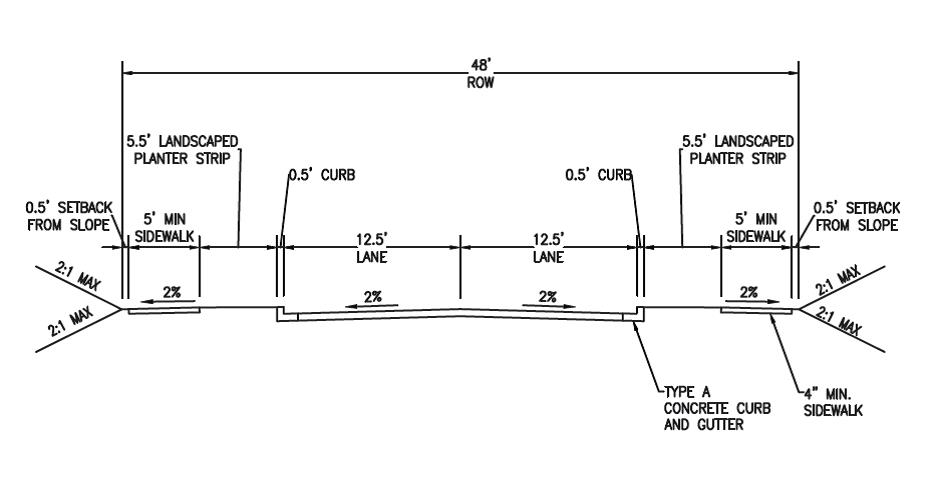
Notes:
1. The minimum allowable depth is two inches asphalt pavement HMA Class 1/2-inch PG64-22 overlying two inches crushed surfacing top course and 10 inches of the Aggregate for Gravel Base Specification 9-03.10 of the 2016 WSDOT Standard Specifications. All thicknesses are compacted depths. Permeable pavements shall be designed per WSDOT Local Agency General Special Provisions.
2. Minimum vertical slope: 0.5 percent.
3. Standards are minimum standards. The public works director may require more than the minimum due to other adopted plans and regulations by the city or as field conditions warrant.
4. Cul-de-sac bulb shall have radius as determined by the fire marshal.
5. The public works director may permit rolled Portland cement concrete curbs for special conditions, such as narrow single-family or duplex lots.
(Ord. 1954 § 5, 2016; Ord. 1859 § 34, 2014; Ord. 1751 § 1 (Exh. A), 2011; Ord. 1685 § 1(Exh. A), 2009; Ord. 1595-06 § 2, 2006; Ord. 1027 § 4, 1990).
12.20.045 Single-family access green street.
The standards for a single-family access green street are as set forth in Exhibit “A-1” which follows.
Exhibit A-1: Single-Family Access Green Street 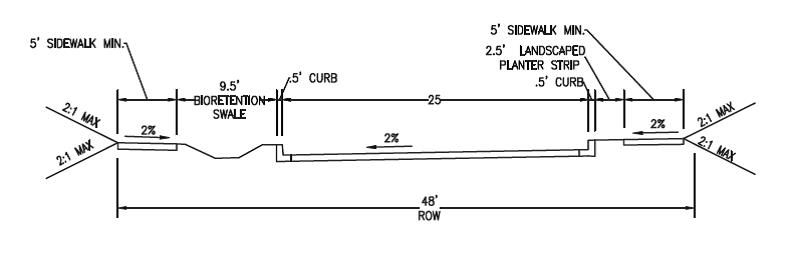
Notes:
1. The minimum allowable depth is two inches asphalt pavement HMA Class 1/2-inch PG64-22 overlying two inches crushed surfacing top course and 10 inches of the Aggregate for Gravel Base Specification 9-03.10 of the 2016 WSDOT Standard Specifications. All thicknesses are compacted depths. Permeable pavements shall be designed per WSDOT Local Agency General Special Provisions.
2. Minimum vertical slope: 0.5 percent.
3. Standards are minimum standards. The public works director may require more than the minimum due to other adopted plans and regulations by the city or as field conditions warrant.
4. Cul-de-sac bulb shall have radius as determined by the fire marshal.
5. The public works director may permit rolled Portland cement concrete curbs for special conditions, such as narrow single-family or duplex lots.
6. Sidewalks shall be constructed of a permeable pavement surfacing unless adjacent to a bioretention facility or other drainage facility designed to manage the runoff from the sidewalk.
7. See bioretention swale definition in FMC Title 21. Bioretention swales shall be engineered in accordance with the stormwater manual (see Chapter 15.32 FMC).
8. Where feasible, curb extensions shall be installed per FMC 21.30.030.
(Ord. 1954 § 6, 2016; Ord. 1859 § 35, 2014; Ord. 1685 § 1(Exh. A), 2009).
12.20.050 Commercial and multifamily access street.
The standards for a neighborhood access street are as set forth in Exhibit “B” which follows.
Exhibit B: Commercial and Multifamily Access Street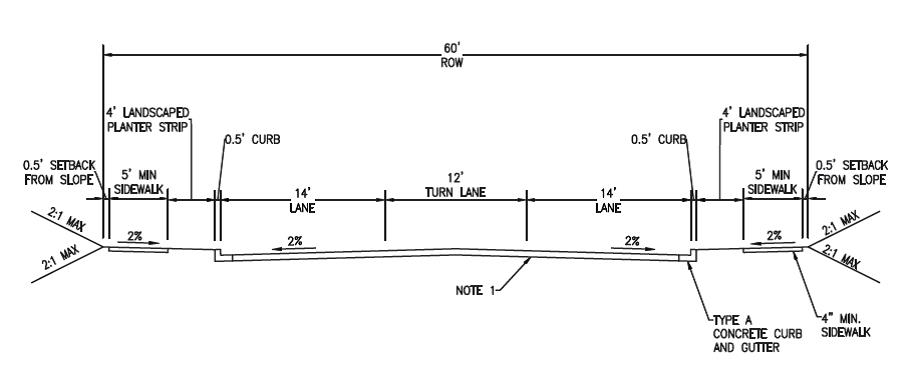
Notes:
1. The minimum allowable depth is four inches asphalt pavement HMA Class 1/2-inch PG64-22 overlying two inches crushed surfacing top course and 16 inches of the Aggregate for Gravel Base Specification 9-03.10 of the 2016 WSDOT Standard Specifications. All thicknesses are compacted depths. Permeable pavements shall be designed per WSDOT Local Agency General Special Provisions.
2. Minimum vertical slope: 0.5 percent.
3. Standards are minimum standards. The public works director may require more than the minimum due to other adopted plans and regulations by the city or as field conditions warrant.
(Ord. 1954 § 7, 2016; Ord. 1859 § 36, 2014; Ord. 1685 § 1(Exh. A), 2009; Ord. 1595-06 § 3, 2006; Ord. 1027 § 5, 1990).
12.20.055 Commercial and multifamily access green street.
The standards for a commercial and multifamily access green street are as set forth in Exhibit “B-1” which follows.
Exhibit B-1: Commercial and Multifamily Access Green Street
Notes:
1. The minimum allowable depth is four inches asphalt pavement HMA Class one-half-inch PG64-22 overlying two inches crushed surfacing top course and 16 inches of aggregate for gravel base specification 9-03.10 of the WSDOT Standard Specifications. All thicknesses are compacted depths. Permeable pavements shall be designed per WSDOT Local Agency General Special Provisions.
2. Minimum vertical slope: 0.5 percent.
3. Standards are minimum standards. The public works director may require more than the minimum due to other adopted plans and regulations by the city or as field conditions warrant.
4. Sidewalks shall be constructed of a permeable pavement surfacing unless adjacent to a bioretention facility or other drainage facility designed to manage the runoff from the sidewalk.
5. See bioretention swale definition in FMC Title 21. Bioretention swales shall be engineered in accordance with the stormwater manual (see Chapter 15.32 FMC).
6. Where feasible, curb extensions shall be installed per FMC 21.30.030.
7. Include permeable pavement (road and/or sidewalk) as an option in lieu of or in addition to bioretention swale.
(Ord. 1954 § 8, 2016; Ord. 1859 § 37, 2014; Ord. 1704 § 5, 2009; Ord. 1685 § 1(Exh. A), 2009).
12.20.060 Collector street.
The standards for a neighborhood collector/collector arterial are as set forth in Exhibit “C” which follows.
Exhibit C: Collector Street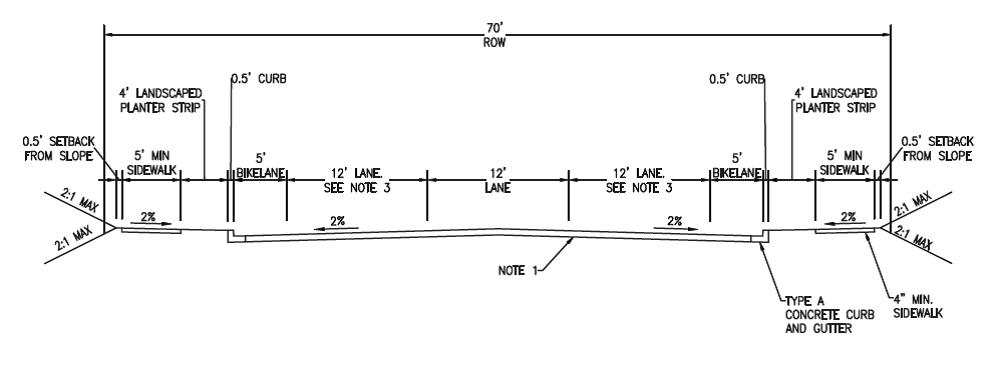
Notes:
1. The minimum allowable depth is four inches asphalt pavement HMA Class 1/2-inch PG64-22 overlying two inches crushed surfacing top course and 16 inches of the Aggregate for Gravel Base Specification 9-03.10 of the 2016 WSDOT Standard Specifications. All thicknesses are compacted depths. Permeable pavements shall be designed per WSDOT Local Agency General Special Provisions.
2. Minimum vertical slope: 0.25 percent.
3. Curb lane 14 feet wide where bike lane not required.
4. Standards are minimum standards. The public works director may require more than the minimum due to other adopted plans and regulations by the city or as field conditions warrant.
(Ord. 1954 § 9, 2016; Ord. 1859 § 38, 2014; Ord. 1685 § 1(Exh. A), 2009; Ord. 1595-06 § 4, 2006; Ord. 1027 § 6, 1990).
12.20.065 Collector green street.
The standards for a collector green street are as set forth in Exhibit “C-1” which follows.
Exhibit C-1: Collector Green Street
Notes:
1. The minimum allowable depth is four inches asphalt pavement HMA Class one-half-inch PG64-22 overlying two inches crushed surfacing top course and 16 inches of Aggregate for Gravel Base Specification 9-03.10 of the WSDOT Standard Specifications. All thicknesses are compacted depths. Permeable pavements shall be designed per WSDOT Local Agency General Special Provisions.
2. Minimum vertical slope: 0.25 percent.
3. Curb lane 14 feet wide where bike lane not required.
4. Standards are minimum standards. The public works director may require more than the minimum due to other adopted plans and regulations by the city or as field conditions warrant.
5. Sidewalks shall be constructed of a permeable pavement surfacing unless adjacent to a bioretention facility or other drainage facility designed to manage the runoff from the sidewalk.
6. See bioretention swale definition in FMC Title 21. Bioretention swales shall be engineered in accordance with the stormwater manual (see Chapter 15.32 FMC).
7. Where feasible, curb extensions shall be installed per FMC 21.30.030.
(Ord. 1954 § 10, 2016; Ord. 1859 § 39, 2014; Ord. 1704 § 6, 2009; Ord. 1685 § 1(Exh. A), 2009).
12.20.070 Minor arterial.
A. The standards for a minor arterial are as set forth in Exhibits “D” and “D-1” which follow.
Exhibit D: Minor Arterial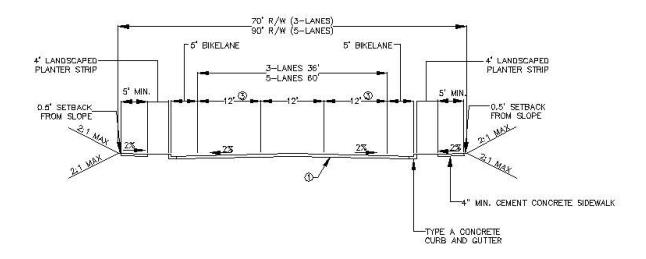
Exhibit D-1: Minor Arterial with Parking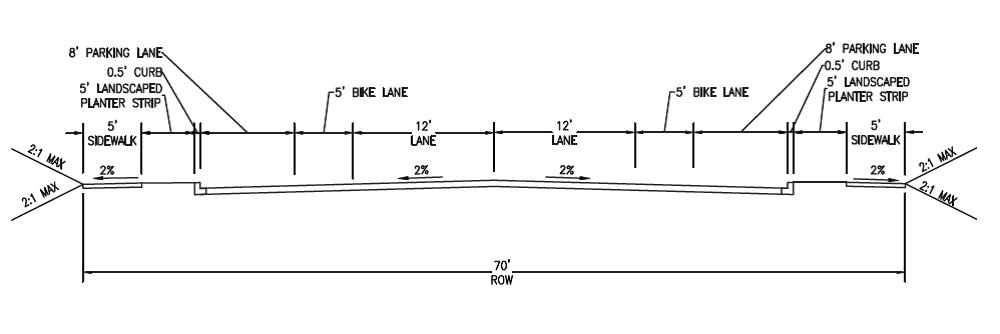
Notes:
1. The minimum allowable depth is four inches asphalt pavement HMA Class 1/2-inch PG64-22 overlying two inches crushed surfacing top course and 16 inches gravel base Aggregate for Gravel Base Specification 9-03.10 of the 2016 WSDOT Standard Specifications. All thicknesses are compacted depths. Permeable pavements shall be designed per WSDOT Local Agency General Special Provisions.
2. Minimum vertical slope: 0.25 percent.
3. Curb lane 14 feet wide where bike lane not required.
4. Standards are minimum standards. The public works director may require more than the minimum due to other adopted plans and regulations by the city or as field conditions warrant.
(Ord. 1954 § 11, 2016; Ord. 1859 § 40, 2014; Ord. 1685 § 1(Exh. A), 2009; Ord. 1674 § 1, 2008; Ord. 1595-06 § 5, 2006; Ord. 1027 § 7, 1990).
12.20.075 Green minor arterial.
The standards for a green minor arterial are as set forth in Exhibit “D-2” which follows.
Exhibit D-2: Green Minor Arterial
Notes:
1. The minimum allowable depth is four inches asphalt pavement HMA Class one-half-inch PG64-22 overlying two inches crushed surfacing top course and 16 inches of aggregate for gravel base specification 9-03.10 of the WSDOT Standard Specifications. All thicknesses are compacted depths. Permeable pavements shall be designed per WSDOT Local Agency General Special Provisions.
2. Minimum vertical slope: 0.25 percent.
3. Curb lane 14 feet wide where bike lane not required.
4. Standards are minimum standards. The public works director may require more than the minimum due to other adopted plans and regulations by the city or as field conditions warrant.
5. Sidewalks shall be constructed of a permeable pavement surfacing unless adjacent to a bioretention facility or other drainage facility designed to manage the runoff from the sidewalk.
6. See bioretention swale definition in FMC Title 21. Bioretention swales shall be engineered in accordance with the stormwater manual (see Chapter 15.32 FMC).
7. Where feasible, curb extensions shall be installed per FMC 21.30.030.
(Ord. 1954 § 12, 2016; Ord. 1859 § 42, 2014; Ord. 1704 § 7, 2009; Ord. 1685 § 1(Exh. A), 2009).
12.20.080 Principal arterial.
The standards for a principal arterial are as set forth in Exhibit “E” which follows.
Exhibit E: Principal Arterial
Notes:
1. The minimum allowable depth is four inches asphalt pavement HMA Class one-half-inch PG64-22 overlying two inches crushed surfacing top course and 16 inches of aggregate for gravel base specification 9-03.10 of the WSDOT Standard Specifications. All thicknesses are compacted depths. Permeable pavements shall be designed per WSDOT Local Agency General Special Provisions.
2. Minimum vertical slope: 0.25 percent.
3. Curb lane 14 feet wide where bike lane not required.
4. Center turn lane or one travel lane in each direction may be omitted in special circumstances.
5. Standards are minimum standards. The public works director may require more than the minimum due to other adopted plans and regulations by the city or as field conditions warrant.
6. Sidewalks shall be constructed of a permeable pavement surfacing unless adjacent to a bioretention facility or other drainage facility designed to manage the runoff from the sidewalk. Permeable pavements shall be designed per WSDOT Local Agency General Special Provisions.
7. Where feasible, curb extensions shall be installed per FMC 21.30.030.
(Ord. 1954 § 13, 2016; Ord. 1859 § 43, 2014; Ord. 1704 § 8, 2009; Ord. 1685 § 1(Exh. A), 2009; Ord. 1595-06 § 6, 2006; Ord. 1027 § 8, 1990).
12.20.085 Levee Road.
The standards for construction of North Levee Road East are shown on Exhibit “F” which follows.
Exhibit F: North Levee Road East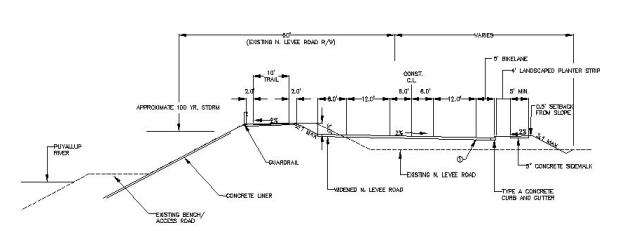
Notes:
1. The minimum allowable depth is four inches asphalt pavement HMA Class one-half-inch PG64-22 overlying two inches crushed surfacing top course and 16 inches of aggregate for gravel base specification 9-03.10 of the WSDOT standard specifications. All thicknesses are compacted depths.
2. Minimum vertical slope: 0.25 percent.
3. Sidewalk/bikeway combinations or sidewalk location and width as required, four-inch depth.
4. Standards are minimum standards. Director of public works may require more than the minimum due to other adopted plans and regulations by the city or as field conditions warrant.
(Ord. 1704 § 9, 2009; Ord. 1685 § 1(Exh. A), 2009; Ord. 1595-06 § 7, 2006).
12.20.090 Additional requirements.
This section contains a series of requirements that apply to improvements required or proposed to be installed in the right-of-way.
A. Dedication of Right-of-Way. If a right-of-way abutting the subject property is not wide enough to contain the required improvements, the applicant shall dedicate as right-of-way a strip of land adjacent to the existing right-of-way adequate to increase the available right-of-way, on the project side of the planned street centerline, to one-half of the needed total width.
B. Fire Hydrants. The applicant shall install fire hydrants where and in the manner specified by the fire marshal and pursuant to Chapter 13.16 FMC.
C. Illumination. Streets shall be illuminated. Fixtures shall have light emitting diode arrays that provide illumination levels of 0.6 foot-candles, minimum, and 1.2 foot-candles, average, except that illumination levels on residential access streets may be reduced to 0.3 foot-candles, minimum, for street segments at least 100 feet from any intersection, and 0.6 foot-candles, average, over their entire length. Fixture type shall be provided in accordance with the following table:
|
|
Street Type |
||||
|---|---|---|---|---|---|
|
Zone |
Alley |
Access |
Collector |
Minor Arterial* |
Principal Arterial |
|
Single-family residential |
None |
B |
A |
A |
B |
|
Small lot residential |
None |
B |
A |
A |
B |
|
Medium density residential |
None |
B |
A |
A |
B |
|
High density residential |
None |
B |
A |
A |
B |
|
Neighborhood residential |
None |
B |
A |
A |
B |
|
Neighborhood commercial |
B |
B |
A |
A |
A |
|
Community commercial |
B |
B |
A |
A |
A |
|
Regional commercial |
B |
B |
B |
A |
A |
|
Business park |
B |
B |
B |
A |
A |
|
Industrial |
B |
B |
B |
B |
B |
|
Public use open |
** |
** |
** |
** |
** |
|
A = Decorative B = Functional (cobra head or shoebox) N/A = Street/zone match does not exist None = No lighting required in right-of-way; illumination provided on buildings *North Levee Road East is a minor arterial, for illumination standards **For public use/open space, illumination to match the highest adjacent zone |
|||||
|
NOTES: 1. Higher standard shall be used for both sides of streets abutted by two zones. 2. Planned residential developments in commercial zones shall use residential development standards in accordance with FMC 19.52.040 and above table. |
|||||
D. Incompatible Improvements. If improvements required by this chapter will connect with existing improvements in the same right-of-way that do not conform to this chapter, the following regulations apply:
1. If the improvements will connect with existing improvements of a greater dimension, the new improvement must be built at the greater dimension unless the public works director determines, in writing, that the dimensions of the existing improvements will be decreased in the future.
2. If the improvements will connect with existing improvements of a lesser dimension, the following regulations apply:
a. If the public works director determines that the dimensions of the existing improvement will not be increased in the future, the new improvement must be permanently flared or tapered to match existing improvements.
b. If the public works director determines that the dimensions of the existing improvements will be increased in the future, the applicant shall install the required improvements in the full length of the right-of-way abutting the subject property with temporary flaring or tapering on the existing improvements.
E. Low Impact Development. See FMC 15.32.020.
F. Low Impact Development Facilities. See FMC Title 21.
G. Low Impact Development Techniques. See FMC Title 21. (Ord. 1916 § 1, 2015; Ord. 1859 § 44, 2014; Ord. 1685 § 1(Exh. A), 2009; Ord. 1647-07 § 1, 2007; Ord. 1027 § 8, 1990).
12.20.100 Design and engineering standards.
A. Chapter 35.78 RCW requires cities and towns to adopt uniform definitions and design standards for major and secondary arterials (as well as pedestrian and bicycle facilities). Standards are set through RCW 35.78.030 and 35.78.040 by a state design standards committee in cooperation with the Washington State Department of Transportation (WSDOT).
These uniform design standards apply to all new construction on major arterial and secondary arterial roads and streets and to reconstruction of such roads and streets as far as practicable. No deviation from the adopted design standards may be made without approval of the WSDOT state aid engineer.
Those standards are published in the WSDOT Local Agency Guidelines (LAG) Manual and include directly or by reference:
1. LAG Chapter 42, City/County Design Standards for All Routes.
2. Accessible Public Rights-of-Way Planning and Design for Alterations (PROWAG), June 2007, and as may be subsequently amended.
3. AASHTO Green Book – A Policy on Geometric Design of Highways and Streets.
B. For other streets the AASHTO Green Book – A Policy on Geometric Design of Highways and Streets, 2018 7th Edition, and as may subsequently be amended, shall apply.
C. The public works director is directed to develop and keep current full engineering standards and specifications for all improvements in the right-of-way. The applicant shall comply with these standards and specifications for all improvements in the right-of-way. The minimum engineering standards are shown in FMC 12.20.040 through 12.20.085, and subsections (A) and (B) of this section. The public works director may require additional engineering specifications for all improvements as field conditions warrant, on a case-by-case basis. (Ord. 2032 § 3, 2020; Ord. 1859 § 45, 2014; Ord. 1027 § 9, 1990).
12.20.110 Modifications, deferments and waivers.
Provisions of this section establish under what circumstances the requirements of this chapter may be modified, deferred or waived.
A. Authority to Grant and Duration. If the proposed development of the subject property requires approval through short plat or subdivision approval described in the subdivision ordinance, a request for modification, deferment or waiver will be considered as a part of that process under the provisions of this section. The public works director shall not grant any modification, deferment or waiver for any standard required as a result of a short plat or subdivision within five years from the date of approval of the short plat or subdivision, nor shall the public works director grant any modification, deferment or waiver of any standard to any note on the face of the plat regarding improvements. If the above process does not apply, the public works director may grant a modification, deferment and waiver from the requirements in this chapter.
B. Process. The applicant shall submit the request for a modification, deferment or waiver in writing, together with two sets of street plans showing both the required improvements and the proposed improvements for which the modification, deferment or waiver is being requested. The public works director shall consider the request, a written recommendation from the community development director and issue a decision, with findings, in writing. The decision shall be final unless appealed under the provisions of Chapter 14.10 FMC (within 20 days from the date of the action being appealed).
C. Modifications. The public works director may require or grant a modification to the nature or extent of any required improvement for any of the following reasons:
1. If unusual topographic or physical conditions preclude the construction of the improvements as required.
2. If other unusual circumstances preclude the construction of the improvements as required. The public works director shall take into consideration the designation and location of the street, the zoning and land use in the immediate area, the projected land use, provision of utilities to serve the area and on-site provisions for parking and maneuvering. A written recommendation from the community development director may be requested by the public works director.
D. Deferment. The public works director may require or permit that the required improvements be installed at a later time:
1. If the required improvement is part of a larger project that has been scheduled for implementation in the city’s capital facility plan – streets; or
2. If the subject proposal is for a single detached dwelling unit and the installation of the improvement would not complete the lesser of a full block face or 300 feet of frontage (alleys are not included for purposes of calculating frontage); or
3. If installation of the required improvement would require substantial off-site roadway modifications; or
4. If the public works department determines that installation of the required improvement would result in a safety hazard.
The public works director shall take into consideration the designation and location of the street, the zoning and land use in the immediate area, the projected land use, the provision of utilities to serve the area and on-site provisions for parking and maneuvering. A written recommendation from the community development director may be requested by the public works director.
E. Deferment Requirements. If the public works director approves a deferment:
1. The applicant and the city must sign a concomitant agreement to run with the property, in a form acceptable to the city attorney, specifying that the applicant will install or reimburse the city for construction of the deferred improvements as directed by the city. The applicant must file this agreement with the Pierce County auditor’s office.
2. The applicant must grade the subject portion of the right-of-way as though the improvement were to be immediately installed and stabilize the graded area in a manner approved by the public works director. The applicant may be exempted from this requirement if the public works director determines that unusual circumstances preclude the grading.
F. Waivers. The public works director may waive and not require or allow installations of a required improvement if the public works director determines that the current level and extent of the improvement in the right-of-way adjacent to the subject property will not be changed in the future. The public works director shall take into consideration the designation and location of the street, the zoning and land use in the immediate area, the projected land use, the provision of public utilities to serve the area and on-site provisions for parking and maneuvering. A written recommendation from the community development director may be requested by the public works director. (Ord. 1954 § 14, 2016; Ord. 1859 § 46, 2014; Ord. 1027 § 10, 1990).
12.20.120 Appeals.
The decision of the public works director may be appealed to the hearing examiner using the appeal provisions of Chapter 2.92 FMC. (Ord. 1859 § 47, 2014; Ord. 1593-06 § 30, 2006; Ord. 1027 § 11, 1990).
12.20.130 Bonds.
The public works director may require or permit a bond in the amount of 150 percent of the cost of the improvement to ensure compliance with any of the requirements of this chapter. The bond shall be in a form acceptable to the city attorney. (Ord. 1859 § 48, 2014; Ord. 1027 § 12, 1990).
12.20.140 Private streets.
Private streets shall meet street standards as determined by the public works director. The public works director shall classify each private street pursuant to FMC 12.20.020, and the applicable standard shall apply. The applicant shall comply with the applicable standard. Modification, deferment and waiver of the standard may be granted pursuant to FMC 12.20.110. (Ord. 1859 § 49, 2014; Ord. 1027 § 13, 1990).


